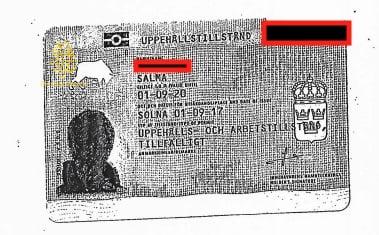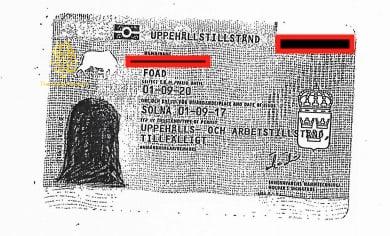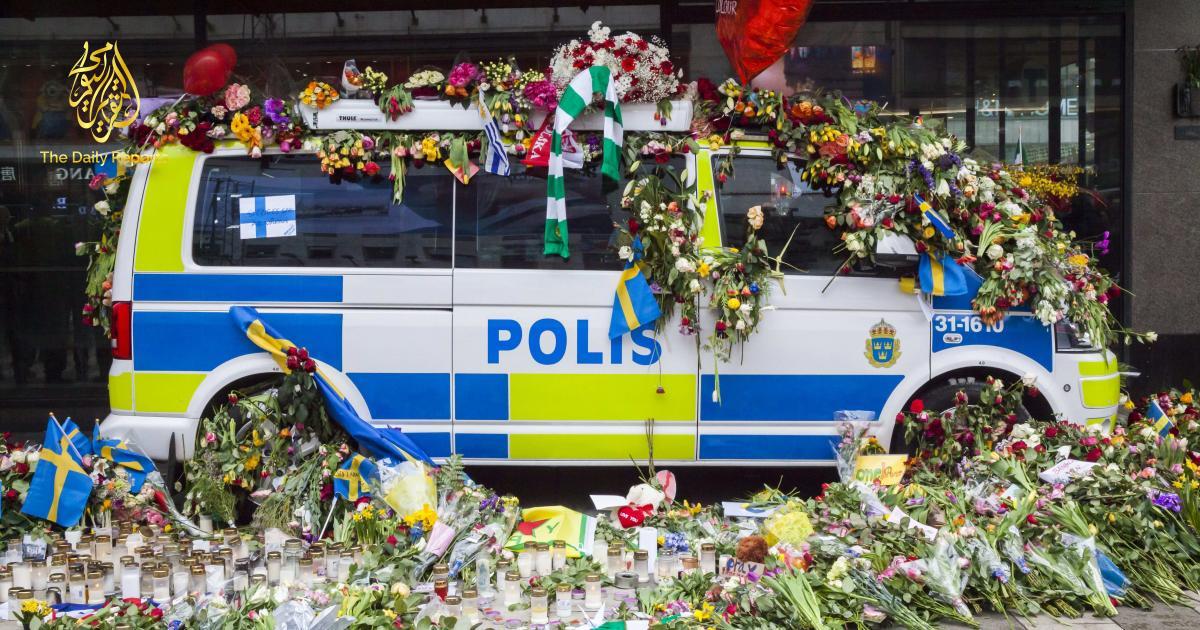On April 6, 2021, Sweden’s security police arrested a woman and a man known only as Salma K. and Fouad M.
Salma and Fouad had come to Europe during the refugee crisis in 2015 and presented themselves as Afghan nationals, respectively aged 22 and 24. Six years on, they were charged with planning an act of terror on Swedish soil.
The Swedish Security Service (SÄPO) recently confirmed they had lied about their ages and nationalities – potentially even their names. Investigations are ongoing, but security police believe the pair may have come to Europe as part of a “sleeper cell” all along.
In early 2015, a tide of desperate refugees and asylum seekers, mostly from Middle Eastern countries, made headlines after arriving on European shores fleeing violence and insecurity in their countries of origin. Many European states’ immigration services were overwhelmed. Lacking in time and resources, they hired part-time workers to process the new arrivals as quickly as possible.
One case on their desk was that of a young couple who claimed they were from Afghanistan, though they spoke with Iranian accents. They asked for an Iranian interpreter because, they said, having lived for many years in Iran they could no longer understand certain words in Dari: the Afghani strain of Persian.
The interpreter translated the man’s statements for Swedish immigration officers thus.
“My name is Fouad M… I entered Sweden on October 28, 2015. I was born in the Afghan province of Kapisa but I lived in Iran.” At the time, he said he was 24 years old, born on June 13, 1991. In fact, both he and his partner were at least 10 years older.

His partner said her name was “Salma K…”, also from Kapisa. She was unable to correctly spell Kapisa in Latin characters. She claimed that she was 22, born on June 8, 1993.

Eventually the Swedish Migration Agency granted the couple political asylum. They had no ID documents to confirm their names or dates of birth, which was fairly common for refugees at that time, so the Swedish residency documents assigned to them only reflected what they had said.
The couple’s first residency permit was valid until 2020. Five months before the permit was due to expire they asked for a three-year extension, which was duly renewed with an expiry date of 2023.
Everything seemed to be in order. The couple did not cause any trouble, were not active on social media and according to their neighbors, lived a very isolated life.
The Swedish paper Expressen reported that according to neighbors, the couple had covered their windows completely and kept them covered throughout the year so they was no way to see what was happening inside their home. But given that they were Muslims and new to the country, the Swedes thought nothing of it.
Six years after the couple’s arrival on April 6, 2021, the Swedish court issued an arrest warrant for them both on suspicion of “conspiracy to commit a criminal terrorist act”.
The targets of the alleged plot were Iranians living in Sweden who opposed the Islamic Republic of Iran, whose names have not been made public. According to the authorities, the pair began planning to carry out an attack in January 2021.
After the Swedish judiciary issued the arrest warrant based on evidence provided to the court, SÄPO started to investigate. A month after their arrest, police concluded their first phase of investigations: Salma and Fouad, it was ascertained, were not Afghan nationals at all and had lied about their ages.
A well-positioned Swedish source told me all the evidence points to their connection to the security agencies of the Islamic Republic. For now at least, it is strongly suspected that their real nationality is Iranian.
Hans Ihrman, a deputy prosecutor at the security court, told Swedish media that in addition to the main charge of terrorism, the couple are also being prosecuted for having lied about their identities. Their computers and mobiles phones were given to IT experts to find out more about them.
Nima Rostami, a Swedish lawyer of Iranian origin who has followed the case, told me the couple “had prepared their statements to the Migration Agency so carefully that they were granted political asylum. When the police arrested them they could not find any pictures of them on social media.
“This made me extremely suspicious. They were professionals who had left no trace. In his recent interviews, the prosecutor said that from the very first they had entered Sweden with the aim of conducting terror operations.”
Recent terror cases in Europe thought to be connected to the Islamic Republic have generally involved one or more people who claimed asylum in the region. In 2018, Iranian diplomat Asadollah Asadi delivered a bag containing explosives to a “refugee” couple named Nasimeh Naami and Amir Saadouni to plant at a gathering of opposition group the People’s Mojahedin Organization outside Paris.
In early May a Belgian court in Antwerp sentenced the couple, along with another former refugee by the name of Mehrdad Erfani, to lengthy prison sentences for their part in the plot. The same month, a high Danish court upheld a seven-year prison sentence for Mohammad Davoudzadeh Loloei, an Iranian asylum claimant in Norway.
“The Iranian government,” Nima Rostami says, “has been trying to infiltrate countries like Sweden, which uphold democracy and the rule of law over anything else and respect human rights, even in the cases of foreigners who ask for asylum. The Iranian dictatorship and the Quds Force exploit this transparent system to conduct terrorist operations.”
On September 6, 1990, Effat Ghazi, the daughter of Ghazi Mohammad, leader and founder of the Democratic Party of Iranian Kurdistan, was assassinated by letter bomb in the Swedish city of Västerås.
“The Swedish police had no interest in talking about the connection between her assassination and Iran,” her widower Amir Ghazi said in an interview in 2015. “I believe they [Sweden] are mainly afraid of Iran and worried about their economic interests in relation to Iran.”
A year earlier in 1989, agents of the Islamic Republic assassinated Gholam Keshavarz, a well-known opposition figure and political asylum claimant in Sweden. Iran’s Intelligence Ministry had kept the family under surveillance and when Keshavarz travelled out to meet his mother in the coastal resort town of Larnaca in Cyprus, Iran sent its agents to kill him.
Two armed assailants on a motorcycle gunned Keshavarz down in front of his wife and mother. A source told me that at least one of the assassins used a car belonging to the embassy of the Islamic Republic to get through police checkpoints. He then drove to the airport, dumped the car there and left the country before he could be identified. The other identified killer had been sent abroad by the Iranian foreign ministry to teach Persian to the children of Iranian diplomats.
As reported by the Abdorrahman Boroumand Center for Human Rights in Iran, one week before his murder Gholam Keshavarz had given a speech in Stockholm entitled “Why and how Iranian refugees should organize”.
In addition to calling for an international, non-partisan organization for Iranian refugees, Keshavarz had expressed concern about the “kidnapping and shooting” of refugees by the Islamic Republic of Iran in neighboring countries such as Turkey and Pakistan. He had even changed his appearance for the lecture so that he would not be recognized.
In 1993 the Swedish police discovered and deactivated a bomb planted in the Stockholm office of the opposition National Council of Resistance of Iran. At the same time, the country expelled three Islamic Republic diplomats on the charge of spying on Iranian refugees.
A recent detailed report by IranWire’s Hannah Somerville notes that several individuals have recently been arrested or have been put on trial in Sweden on charges such as spying for the Islamic Republic or engaging in terrorist activities.
In December 2019 a 46-year-old Iraqi-born citizen of Sweden, Raghdan al-Hraishawi, was jailed for two and a half years for spying on Iranian Arabs and members of the exiled Arab Struggle Movement for the Liberation of Ahvaz.
In October 2018, Mohammad Davoudzadeh Loloei, an Iranian-Norwegian dual national, was arrested at Gothenburg Airport as he was returning from Tehran and extradited to Denmark to go on trial.
These two had related missions: gather information on the Iranian Arab population abroad, and stage a terror attack on the group. News of the conviction of Raghdan al-Hraishawi was published a full year after his arrest.
The case against Salma and Fouad, if it holds, will be the latest in this chain of disturbing events. It has also already led the police to other individuals, whose names have not yet been published even in part because they are still being questioned.
The Swedish Security Service recently warned that Iran’s espionage activities are on the increase in several European countries. In January 2021, I received information that security agencies across northern Europe were investigating the Islamic Republic’s activities within their borders based on the content of Asadollah Asadi’s recovered notebooks.
The green notebook seized from Asadi’s rented Ford contained 289 entries, handwritten in both Latin and Persian scripts, detailing sums of money he had paid and various addresses in Europe. The times and dates were also noted down.
These entries showed that several individuals with very common Iranian given or family names – mostly aliases – had received cash from Asadi in wages, operational expenses and “financial aid”. Some had also signed the notebook to acknowledge payment. Most of the payments listed, in around 144 notes, were linked to Germany and one of the addresses listed was that of the Islamic Center in Hamburg.
In her report, Hannah Somerville highlights the supposedly “religious and cultural” activities of another center in Sweden: the Imam Ali Islamic Center in Stockholm, a Shia cultural hub founded in 1997 that is widely thought to be close to the regime. The Center and its 33 offices around the country regularly host delegations from the Iranian embassy. In 2012, the center held an “Iranian Culture Week” at City Hall in Lund that was sponsored by the Iranian embassy.
Following the successful intelligence coups against Iranian operatives in Europe in 2018, the names of many suspects, including those in Asadi’s notebooks, and the people with whom they have been in contact are being subjected to intense scrutiny by European security agencies.
Perhaps it is apt to relate an episode from trial of Asadollah Asadi and his three accomplices in Antwerp. An official of the court confirmed that “for the moment”, only these four individuals have been convicted in relation to the planned operation. But those whose names and addresses are listed in the green notebook, it was said, were “unlikely to sleep easy for quite some time.”
In her report, Hannah Somerville highlights the supposedly “religious and cultural” activities of another center in Sweden: the Imam Ali Islamic Center in Stockholm, a Shia cultural hub founded in 1997 that is widely thought to be close to the regime. The Center and its 33 offices around the country regularly host delegations from the Iranian embassy. In 2012, the center held an “Iranian Culture Week” at City Hall in Lund that was sponsored by the Iranian embassy.
Following the successful intelligence coups against Iranian operatives in Europe in 2018, the names of many suspects, including those in Asadi’s notebooks, and the people with whom they have been in contact are being subjected to intense scrutiny by European security agencies.
Perhaps it is apt to relate an episode from the trial of Asadollah Asadi and his three accomplices in Antwerp. An official of the court confirmed that “for the moment”, only these four individuals have been convicted in relation to the planned operation. But those whose names and addresses are listed in the green notebook, it was said, were “unlikely to sleep easy for quite some time.”








